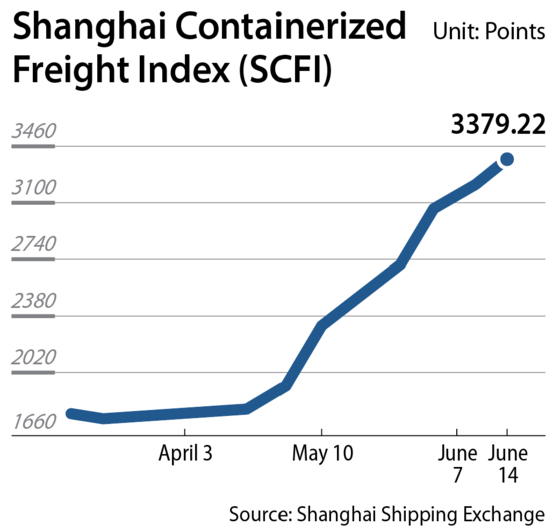Shipping rates threaten to sink Korean exporting firms
Published: 21 Jun. 2024, 14:07
Updated: 21 Jun. 2024, 15:15
![Containers are stacked at the export yard in Pyeongtaek Port, Pyeongtaek-si, Gyeonggi-do. [NEWS1]](https://koreajoongangdaily.joins.com/data/photo/2024/06/21/ec47bcd9-77ff-4173-8d1a-176949b7a160.jpg)
Containers are stacked at the export yard in Pyeongtaek Port, Pyeongtaek-si, Gyeonggi-do. [NEWS1]
Korea companies that export to the United States are grappling with rising costs as shipping rates have skyrocketed.
“Even at $10,000, it is difficult to secure container space. Around 30 percent of the cargo volume intended to be sent to the United States cannot be shipped," a spokesperson of an auto parts exporting company said.
Earlier this year, the container charter freight rate for routes to the east coast of the United States was around $2,500 per 40-foot equivalent units (FEU), based on a standard 40-foot (12-meter) container. However, this rate has skyrocketed up to $8,000.
Despite the tripling of the base freight rate, container space still commands a premium due to the limited number of containers.
Export companies are facing a difficult situation due to the soaring freight rates. There are also concerns that global shipping rates may rise further as China increases its cargo volume in anticipation of trade sanctions.

The Shanghai Containerized Freight Index, which indicates container ship freight rates, recorded 3,379.22 points as of June 14, up 194.35 points from the previous week, marking a continuous rise for the past 10 weeks since March 29.
After surpassing 3,000 points on May 31 for the first time since the Covid-19 outbreak, the rate has surged twice.
Rates keep surging on the back of unresolved tension in the Red Sea and the drought affecting the Panama Canal, among other problems. Recently, the increase in North America's export volume from China has also contributed to the rise.
China has begun to prepare for the possibility of intensified trade sanctions by increasing the volume of goods sent to the United States, Mexico and Canada, leading to a sharp rise in rates for routes to North and South America.
Chinese companies are shipping goods to Mexico or Canada to circumvent U.S. sanctions, with Washington set to increase tariffs on Chinese electric vehicles, batteries, semiconductors and solar panels from 25 percent to a maximum of 100 percent starting in August.
The rate for the U.S. East Coast route was $7,447 per FEU, up $241 from the previous week. The West Coast route was $6,209 per FEU, up $41, while the South American route surged by $528 in one week to $7,936 per FEU, as of Wednesday.
"The prolonged Red Sea crisis, along with China's push for volume increases, is expected to continue for some time. Global shipping companies, which are currently benefiting, are likely to limit ship capacity to maintain high prices, and thus, the high prices may persist until the end of the year," noted Lim Taek-gyu, director of the Korea International Freight Forwarders Association.
As shipping rates rise, air freight rates are also increasing. As ships detour around the southernmost tip of Africa past the Cape of Good Hope instead of traveling through the Suez Canal, the increased travel distance and time have resulted in urgent exports shifting to the air.
According to the Hong Kong TAC Index, which publishes the global air freight index, the Baltic Air Freight Index, recorded 2,144.00 as of Monday, up 35 points or 1.7 percent from the previous week, marking a yearly high. This figure has risen by nearly 20 percent compared to the yearly low of 1,787.00 recorded on February 26.
Air freight rates are also climbing on the back of an increase in e-commerce shipments from China, with fulfillment by Korean airlines spiking.
The international cargo transported by 11 domestic airlines from January to May this year was 1,154,436 tons, an increase of 17.2 percent on year, marking the highest volume since data was first logged in 2009, according to the Ministry of Land, Infrastructure, and Transport's Aviation Information Portal System.
"If the increase in freight rates is fixed, the rise in logistics costs will reduce the profits of export companies. The increased logistics costs will also be passed on to consumers, as it will increase the burden tacked onto small overseas direct purchase items," a logistics industry official added.
BY PARK YOUNG-WOO, YI WOO-LIM, CHOI HAE-JIN [choi.haejin@joongang.co.kr]










with the Korea JoongAng Daily
To write comments, please log in to one of the accounts.
Standards Board Policy (0/250자)